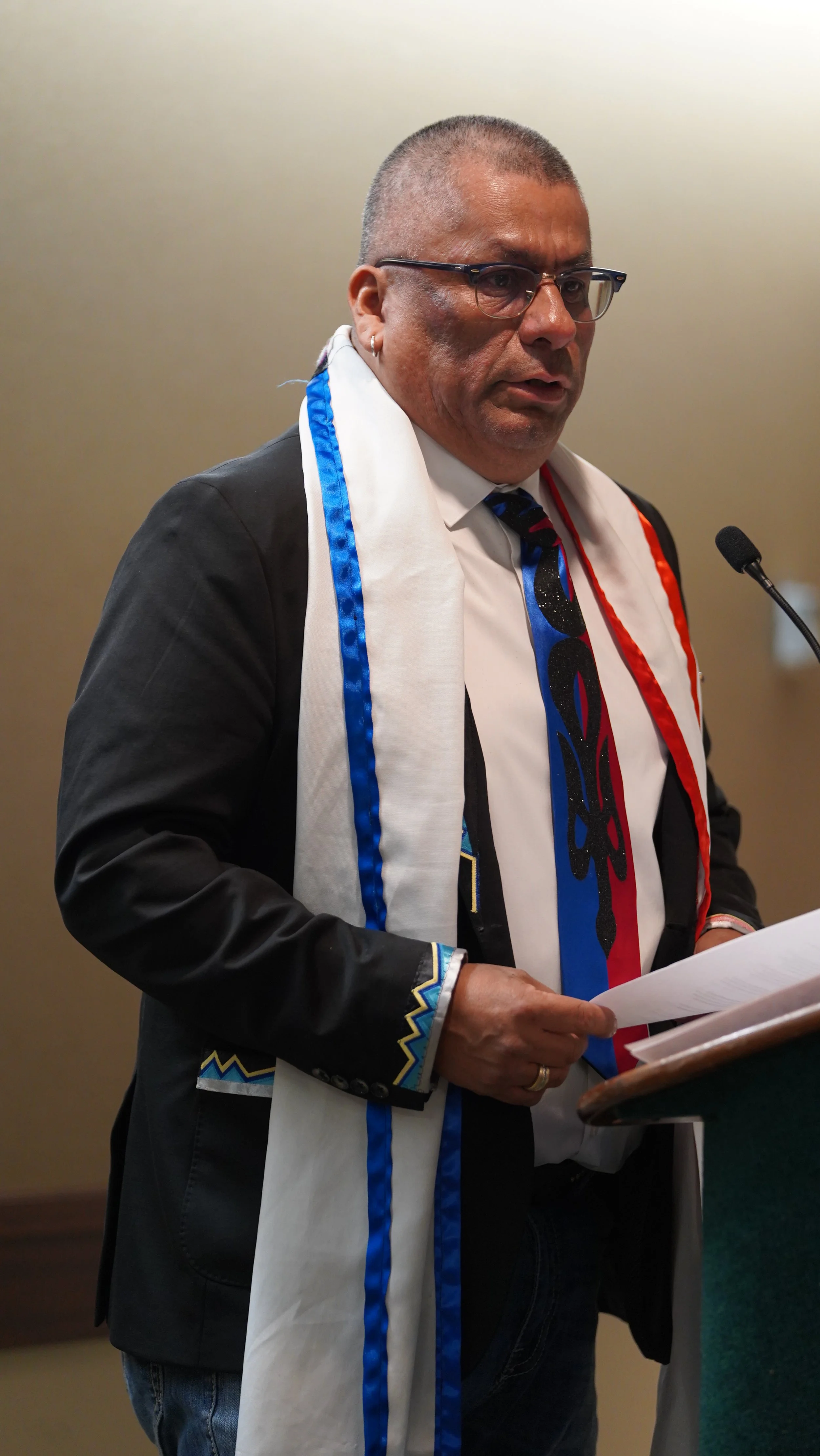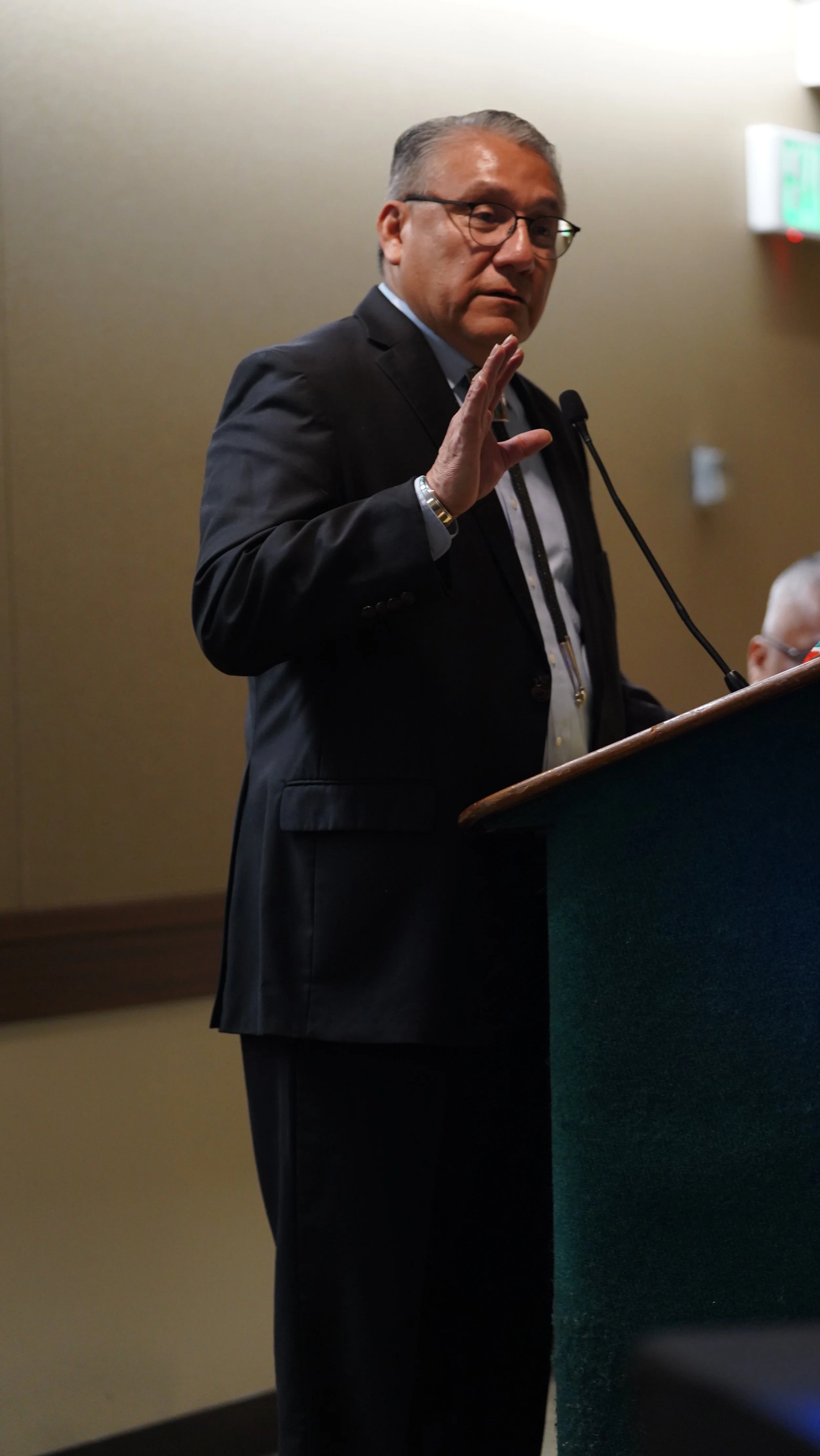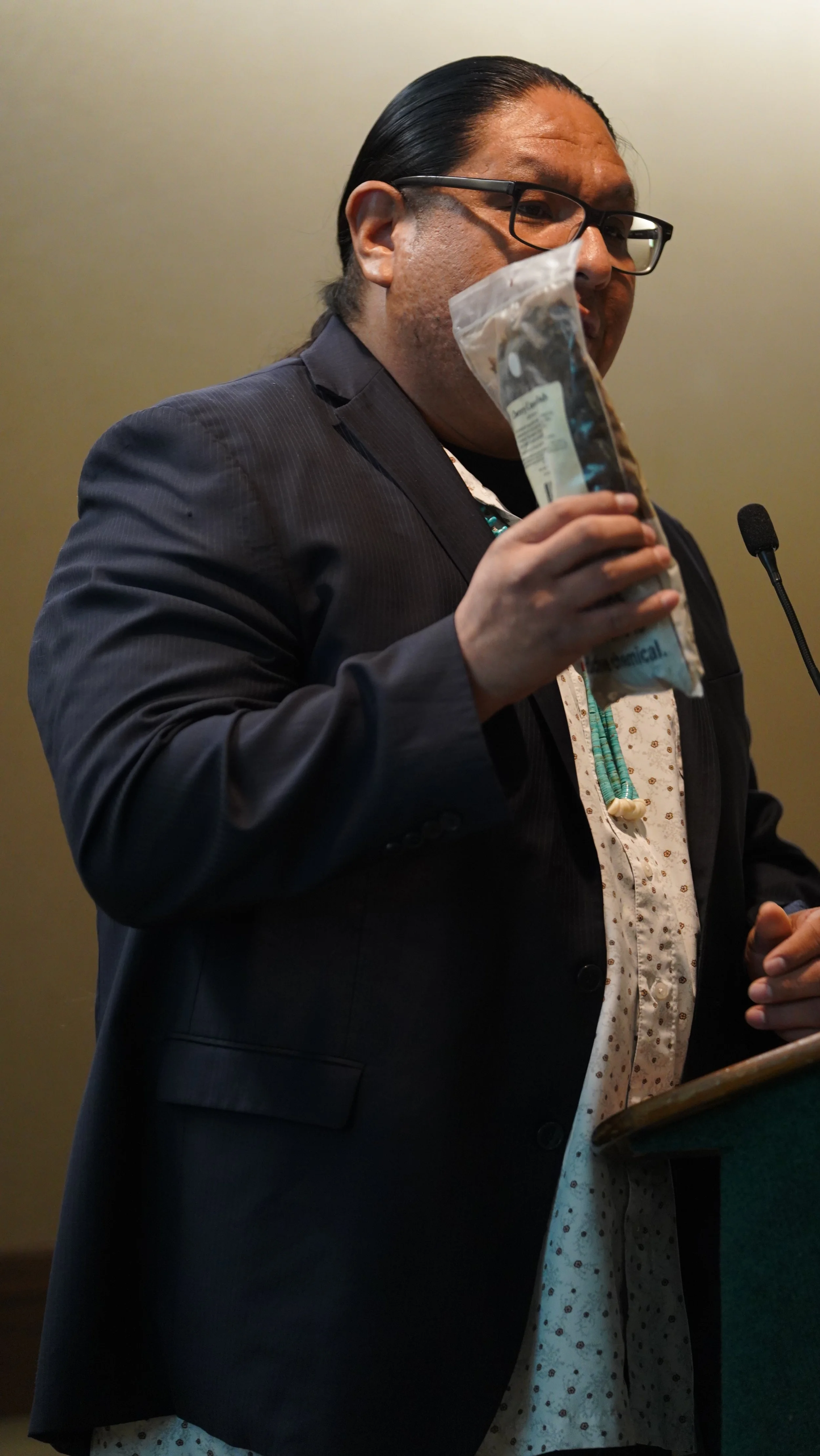NCAI Peyote Task Force Reignites Efforts to Strengthen American Indian Religious Freedom Act
By Darren Thompson
Seattle—The Native American Church of North America (NACNA) continued its advocacy at the National Congress of American Indians' (NCAI) 82nd annual convention in Seattle last week. NACNA, a leader and organizer of NCAI's Peyote Working Group, hosted a 4 hour meeting on Wednesday, Nov. 19 at the Seattle Convention Center, during NCAI’s annual convention to emphasize the importance of protecting peyote, sacred sites, and the American Indian Religious Freedom Act (AIRFA).
Jon Brady, a citizen of the Mandan, Hidatsa and Arikara Nation and the President of the Native American Church of North America, speaks at the National Congress of American Indians’ Peyote Working Group in Seattle, Washington on November 19, 2025. Photo by Darren Thompson
Tribal leaders, ceremonial leaders, and supporters joined the meeting to hear of the history of advocacy within NCAI and by NACNA on a national level to protect the natural habitat of peyote, which leaders say is under threat, and to advocate for enforcement of the 1978 AIRFA and its 1994 amendment. The 1994 amendment specifically aimed to protect the traditional, ceremonial use of peyote by Native Americans, enrolled in federally recognized tribes—making it lawful and immune to prohibition by federal or state governments.
“We have over 40 years of resolutions, since the passing of the American Indian Religious Freedom Act,” said NACNA President Jon Brady during the Peyote Working Group's meeting on Nov. 19. "So, today, we’re trying our best to get some enforcement from our tribal leadership. We're trying our best to implement all of these resolutions.”
NCAI is the oldest, largest, and most representative American Indian organization the country, and began in 1944 to strengthen and preserve tribal sovereignty. The storied organization has decades of history in advocating for tribal issues in Washington, D.C, and more than 200 tribes pay membership fees to the organization annually to ensure the organization advocates for issues facing tribes and their citizens. Not all tribes are members of NCAI, though, and it is important to note that tribes retained sovereignty, and a government-to-government relationship with the federal government, and not a nonprofit organization. NCAI's primary function is to organize tribes, and push for resolutions as a unified body to present to Congress, the White House, and other federal agencies when in discussion about tribal issues.
“I was one of the first tribal chairmen to give a resolution to support this cause, because our sovereignty and our way of life is under attack,” said Northern Arapaho Tribal Chairman Keenan Grossbeck during the Peyote Working Group on Nov. 19. "There's encroachment every day on our way of life.”
Founded in 1918, NACNA is the oldest American Indian intertribal religious organization in the country and has historically been the entity that advocates for the use, possession, and transportation of the plant peyote. Only members of federally recognized tribes are permitted to use peyote in bona fide ceremonies, but its recreational use is widely reported by the non-Native psychedelic community. Peyote is labeled by the federal government as a Schedule I substance under the Controlled Substances Act (CSA) and its active ingredient, mescaline, has had efforts in the last few years to decriminalize it. Peyote only grows on private lands in four southern counties in Texas, and while possession of peyote is permitted under the law, the land it grows on is not protected. Leaders of NACNA strongly oppose efforts to decriminalize mescaline, and say there is not an efficient method to determine the difference where mescaline actually comes from.
“What binds us together is our inherited sovereignty, and if we weren't talking about it, these issues would be at the bottom of the list,” NACNA General Counsel Justin Jones. Jones also spoke of the green movement, specifically of wind turbines and their encroachment on sacred sites.
Justin Jones, a citizen of the Navajo Nation and the Native American Church of North America’s General Counsel speaks to tribal leaders during the Peyote Working Group at the National Congress of American Indians 82nd annual convention in Seattle, Washington on November 19, 2025. Photo by Darren Thompson.
“People are talking about the air, the water, the land, and how it's sacred,” Jones said. “They’re out there, but they're not us. Some of us, we buy into that, but what is the reality of that? But why are our sacred sites continually desecrated?”
Since AIRFA’s 1994 amendment, leaders have said that violations of the law have been ignored, leading to the widespread appropriation of the use of peyote, which results in a shortage of the plant largely influenced by the psychedelic movement. The 1960s, widely known as the “hippie era”, began accessing and misusing psychedelics and as a result the federal government passed the Drug Abuse Law of 1965, and then later the Controlled Substances Act of 1970, which made peyote allege in the U.S. with exemptions for the use of peyote for ceremonial use by federal recognized tribes, and not state recognized tribes. The American Indian Religious Freedom Acts of 1978 and its 1994 Amendments established legal protections.
Currently, there are several psychedelic churches throughout the U.S. and the world who are organizing to receive a religious exemption. From 2016 to 2024, the U.S. Drug Enforcement Agency (DEA) received 24 petitions religious exemptions under the American Religious Restoration Act (ARRA) of 1993. Currently, 6 of the 24 petitions have been reviewed, with 3 applications withdrawn, and 3 will be reviewed by the DEA in 2026.
Recently, psychedelic churches and organizations announced they plan to file a federal lawsuit against the U.S. DEA, challenging the DEA’s religious exemption for access to plant medicines such as peyote, mushrooms and other plants. The lawsuit could have a serious impact on the American Indian Religious Freedom Act of 1978 and its Amendments of 1994.
Earlier this year, a psychedelic church in Spokane, Washington, received the first ARRA exemption without a DEA lawsuit. The Church of Gaia, views ayahuasca as a religious sacrament, as do several Indigenous communities of South America’s Amazon basin. Technically, the DEA has provided a path for religious groups to receive Controlled Substances Act (CSA) exemptions under the Religious Freedom Restoration Act (RFRA). RFRA was passed shortly after the infamous 1990 Supreme Court case Employment Division of Oregon v. Smith, where Al Smith, a member of the Native American Church, was terminated from his employment for using peyote in ceremonies.
Hershel Walker, a citizen of the Navajo Nation and a public health official, addresses tribal leaders at the National Congress of American Indians’ Peyote Working Group on November 19, 2025. Photo by Darren Thompson,
However, ceremonial leaders see major problems with the continued efforts to establish psychedelic churches. For example, psychedelic churches are developing certification programs and training to certify shamans or traditional practitioners who will facilitate to incorporate Indigenous knowledge into psychedelic treatment centers. “This opens the door for many because anyone can self-identify as Indigenous," said Hershel Walker, a public health professional and a Navajo Nation citizen during NCAI’s Peyote Working Group on Nov. 19. “This may be a loophole for non-Indians and psychedelic interest groups.”
“There is an urgent need for tribal leaders to step in and request tribal consultation with the DEA regarding the petitions for religious exemption by the psychedelic churches,” said Walker.
“Peyote is federally protected for tribes—not nonprofits, not psychedelic organizations," Brady said. "Peyote is not a drug, it is a sacred covenant for our ceremonial nations. The sacrament peyote is a covenant, a prayer, a way of life—a sovereign identity and living relative.”
Darren Thompson is the Managing Editor of Last Real Indians Native News Desk and the Director of Media Relations for the Sacred Defense Fund, an Indigenous-led nonprofit organization based in Santa Fe, New Mexico. He’s an award winning multimedia journalist enrolled at Lac du Flambeau Band of Lake Superior Chippewa, where he grew up. He can be reached at darren@sacreddefense.org.



